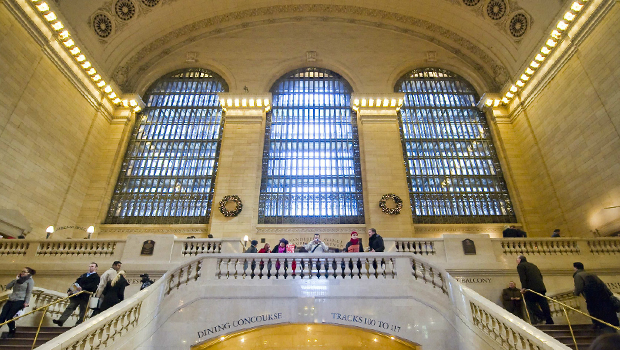Famous Sights – Grand Central Station
In 1869, the railroad tycoon Cornelius “Commodore” Vanderbilt had consolidated his train lines at 4th Ave. (Park Ave.) and 42nd Street at the Grand Central Depot. It was replaced with the current Grand Central Terminal (often called Grand Central Station) (1903-1913) designed by the architectural firms of Reed and Stem and Warren and Wentmore. The slow pace of the contruction is easy to understand when one considers that the trains continued to travel, and by 1906 to over 600 trains were entering and exiting the station per day.
The main façade of the Terminal is a magnificent Beaux-Arts triumphal arch – the Beaux Arts style refers to the Ecole des Beaux Arts in Paris where many nineteenth and early twentieth architects were trained in the grand manner of European style architecture. This styple emphasizes rationality of plan, immense size, and grandiose decoration. The “triumphal arch” of Grand Central greets the visitor arriving from the south, from the north the view is today completely covered by the Grand Central Office building, now the Helmsley, built in 1928, and by the Met Life building, built in 1963. The elevation of Park Avenue around the Terminal allows traffic to flow smoothly through the city, while isolating the main building even more from its surroundings. In spite of the great changes that have occurred nearby, the Terminal remains magnificently centered on its platform on 42nd Street.
The interior was designed to make a strong impact on travelers with its vast height and space, yet this impact was tempered by the slow arrival of passengers from one area to another. The carefully graded system of marble-lined ramps and corridors, lined with amenities such as shops, restaurants, and art galleries, allowed the weary traveler to slowly make the transition to the outside world, to waiting taxis and the comfort of two luxurious hotels nearby.
The main façade is dominated by the large arched windows, and the sculptural group of Mercury (Commerce), Hercules (Physical Energy) and Minerva (Intellectual Energy). The plaster decoration and the constellations on the inside enliven the great interior space which was modeled after ancient Roman baths. The building itself is a steel frame sheathed in granite and limestone, with marble, travertine and painted plaster surfaces on the interior. A totally new scale of electric lighting had to be invented for the interior of the Terminal, as well as for the elaborate system of electric signaling. Elevators were used to move passengers, and pneumatic tubes were used for tickets and baggage. Decorative details in polished brass and gilt bronze delight the eye throughout the Terminal, including oak leaves and acorns from the Vanderbilt coat of arms. The ceiling is also decorated with the Vanderbilt coat of arms on the curved pendentives above the lunette windows on the long sides of the terminal. The plaster vault is painted blue, and gold constellations were added by the French artist Paul Helleu, with the brightest stars picked out in small electric lights.
Over the years many proposals have been made that would radically modify or even completely obscure the Terminal. Fortunately the only eyesore constructed has been the Pan Am building, and others have been blocked from adding office towers and even bowling alleys on top of the magnificent Beaux Arts structure. Grand Central was declared a Landmark by the then-newly created Landmarks Preservation Commission in 1965.










